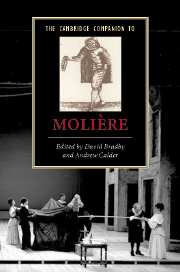Book contents
- Frontmatter
- 1 The career strategy of an actor turned playwright: 'de l’audace, encore de l’audace, toujours de l’audace’
- 2 The material conditions of Molière’s stage
- 3 The master and the mirror: Scaramouche and Molière
- 4 Molière as satirist
- 5 How (and why) not to take Molière too seriously
- 6 L’Avare or Harpagon’s masterclass in comedy
- 7 Laughter and irony in Le Misanthrope
- 8 Comédies-ballets
- 9 Le Bourgeois gentilhomme: Molière and music
- 10 Medicine and entertainment in Le Malade imaginaire
- 11 Molière and the teaching of Frenchness: Les Femmes savantes as a case study
- 12 L'École des femmes: matrimony and the laws of chance
- 13 Molière nationalised: Tartuffe on the British stage from the Restoration to the present day
- 14 Landmark twentieth-century productions of Molière: a transatlantic perspective on Molière: mise en scène and its historiography
- 15 Dom Juan the Directors’ Play
- 16 ‘Reculer pour mieux sauter’: modern experimental theatre’s debt to Molière
- Select bibliography
- Index
- Series List
4 - Molière as satirist
Published online by Cambridge University Press: 28 March 2007
- Frontmatter
- 1 The career strategy of an actor turned playwright: 'de l’audace, encore de l’audace, toujours de l’audace’
- 2 The material conditions of Molière’s stage
- 3 The master and the mirror: Scaramouche and Molière
- 4 Molière as satirist
- 5 How (and why) not to take Molière too seriously
- 6 L’Avare or Harpagon’s masterclass in comedy
- 7 Laughter and irony in Le Misanthrope
- 8 Comédies-ballets
- 9 Le Bourgeois gentilhomme: Molière and music
- 10 Medicine and entertainment in Le Malade imaginaire
- 11 Molière and the teaching of Frenchness: Les Femmes savantes as a case study
- 12 L'École des femmes: matrimony and the laws of chance
- 13 Molière nationalised: Tartuffe on the British stage from the Restoration to the present day
- 14 Landmark twentieth-century productions of Molière: a transatlantic perspective on Molière: mise en scène and its historiography
- 15 Dom Juan the Directors’ Play
- 16 ‘Reculer pour mieux sauter’: modern experimental theatre’s debt to Molière
- Select bibliography
- Index
- Series List
Summary
Miroirs dans les logis, miroirs chez les marchands,
Miroirs aux poches des galands,
Miroirs aux ceintures des femmes . . .
[Mirrors in the houses, mirrors in the shops,
Mirrors in the pockets of the fops,
Mirrors on the belts of the ladies . . . ]
La Fontaine, ‘L’Homme et son image’, Fables I, xiIn rewriting the myth of Narcissus, La Fontaine reminds us that nothing was so hard to avoid in seventeenth-century France as were mirrors. It is a statement both literally and figuratively true. In concrete terms, the Hall of Mirrors at Versailles is the most famous example of a rage for reflective glass that produced, among other crazes, the explosion of miniature mirror fashion-accessories described by La Fontaine. More broadly speaking, the ubiquitous mirror was perfectly indicative of a powerful collective obsession with individual reputation: that is, with the reflection of personal honour, wit and respectability displayed in the mirror of others' opinions. The birth of a new leisured class under absolute monarchy - characterised by an increasingly powerless aristocracy seeking what distinction it could find in personal cultivation and charm (and from a bourgeoisie emulating its glamour) - created a world in which personal worth was determined less by political or economic power than by the value of one's stock in the social exchange. Both nobles and the rich bourgeoisie played their role in the social comedy of court or town before an audience of critical and ever-gossiping peers, and they carefully gauged their image as reflected in their aristocratic circles, their literary salons or, more mundanely, their neighbouring bourgeois homes.
- Type
- Chapter
- Information
- The Cambridge Companion to Moliere , pp. 57 - 70Publisher: Cambridge University PressPrint publication year: 2006



